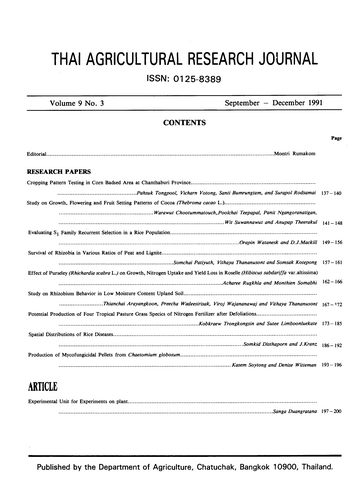Spatial Distributions of Rice Diseaseases
Keywords:
rice, Pyricularia oryzae, Sarocladium oryzae, yellow orange leaf virus (YOLV), dirty panicle, spatial distributionAbstract
Experiments were carried out at the Pathumthani rice Research Centre and in a farmer's field in 1986 using the rice cultivar RD 23 with direct seeding and transplanting. Five hundred and thirteen hills in a grid had been tagged in the experimental plots to respresent the "true" deisase incidence of the entire plant population. the spatial distribution of leaf and neck blast, sheath rot, VOLV and dirty panicle in various fields and seasons were analyzed by means of the Morisita index and the variance - to - mean ratio. The effect of various quadrat sizes on both the indices and their statistical significance for contiguous and random placement was tested. Differences existed for incidence levels only, not for diseases, localties and cropping practices. At low incidence (about less than 50%) the disease patterns were aggregated but spatial distribution was randowm with higher incidence of these rice diseases. But as there are exceptions pilot studies of the disease incidence at which the actural spatial distribution becomes random should precede the decision for an appropriate sampling method.
Downloads
Published
How to Cite
Issue
Section
License

This work is licensed under a Creative Commons Attribution-NonCommercial-NoDerivatives 4.0 International License.
Thai Agricultural Research Journal



